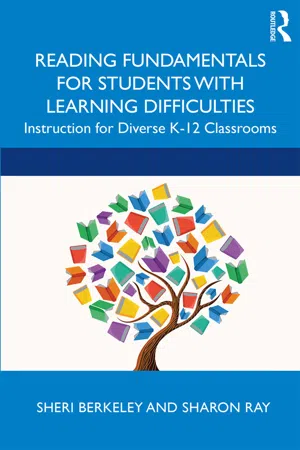
Reading Fundamentals for Students with Learning Difficulties
Instruction for Diverse K-12 Classrooms
- 256 pages
- English
- ePUB (mobile friendly)
- Available on iOS & Android
Reading Fundamentals for Students with Learning Difficulties
Instruction for Diverse K-12 Classrooms
About this book
Reading Fundamentals for Students with Learning Difficulties is a foundational resource on reading instruction for students with learning difficulties. This comprehensive, practical textbook provides fundamental information related to typical and atypical reading development, reading instruction within K-12 classrooms, and how to identify reading problems and provide interventions to a wide range of students who struggle to learn. Throughout the text, cutting edge research on reading instruction for students with learning disabilities and English Learners is translated to practice, making it accessible to even the most novice teachers. Each section concludes with application activities, including self-tests and discussion prompts, to reinforce learning.
Frequently asked questions
- Essential is ideal for learners and professionals who enjoy exploring a wide range of subjects. Access the Essential Library with 800,000+ trusted titles and best-sellers across business, personal growth, and the humanities. Includes unlimited reading time and Standard Read Aloud voice.
- Complete: Perfect for advanced learners and researchers needing full, unrestricted access. Unlock 1.4M+ books across hundreds of subjects, including academic and specialized titles. The Complete Plan also includes advanced features like Premium Read Aloud and Research Assistant.
Please note we cannot support devices running on iOS 13 and Android 7 or earlier. Learn more about using the app.
Information
Section IV
Understanding Text
Section IV: Overview
- Chapter 10: Reading Comprehension
- Chapter 11: Background Knowledge (Including Vocabulary)
- Chapter 12: Supporting All Students in Understanding Text
Guiding Questions
- What are the major processes of reading comprehension?
- How are reading strategies most effectively taught?
- What instructional approaches foster reading comprehension?
- What types of vocabulary words are important to teach?
- What instructional approaches support building and activating background knowledge?
- What instructional approaches foster vocabulary acquisition?
- What challenges do at-risk students have with understanding text?
- What assessments are used to informally assess a student’s ability to understand text?
- What additional instructional supports are needed for readers who struggle to understand text?
Chapter 10
Reading Comprehension
Fundamentals of Reading Comprehension
Types of Text
Narrative Texts
Expository Texts
Text Structure | Definition | Example |
Description (also called explanatory) | lists of related facts (order is not important) |
|
Sequential | temporal listing where time order is important |
|
Compare/Contrast | similarities and differences between people, events or concepts |
|
Problem/Solution (also called cause/effect) | description of a response to an event (problem) |
|
Reading Comprehension Strategies

Plan
Instruction Component | Purpose |
Why to use a strategy. | Students are more motivated to use strategies when reading if they understand why the strategy will help. |
How to use a strategy. | Students need to know how to follow the steps of the strategy. Sometimes a mnemonic or visual cue is used to help students remember all of the steps. |
When to use a strategy. | Students need to understand when a strategy will be appropriate. This is an important step because students who rigidly apply strategies to texts that do not fit the strategy may abandon the... |
Table of contents
- Cover
- Half Title
- Title Page
- Copyright Page
- Dedication Page
- Table of Contents
- Acknowledgments
- Section I Introduction to Reading Instruction and Assessment
- Section II Foundations of Early Reading and Writing
- Section III Accessing Text
- Section IV Understanding Text
- Section V Writing and Spelling
- Appendix A
- Appendix B
- Appendix C
- Appendix D
- Index